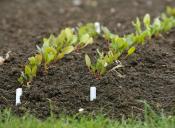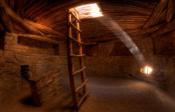Search
Login
Recommended
The system of automatic irrigation in the garden. Autowatering of flowers and plants
For an evergreen lawn, continuous flowering of plants and other plantings, water is needed, the lack of which is manifested in the decay and yellowing leaves of the vegetation. At the same time, watering a personal plot takes a lot of time and effort, especially in a dry summer, and manually shedding the soil to the required depth is quite problematic. Eliminate these and most other shortcomings helps the installation of an automatic watering system.
Content
- Types of irrigation systems
- Pros and Cons of Autowatering
- Autowatering system elements
- Types of watering heads video
- Installation of automatic irrigation system
Types of irrigation systems
Based on the degree of human participation in the process of watering the site, we can distinguish 3 well-known species:
- Manual watering comes down to using a watering can or a hose;
- The automatic irrigation system is based on the operation of the controller, timely managing the entire irrigation process from switching on to stopping the supply of water;
- Semi-automatic irrigation is based on manually turning on / off the water entering the stands through specially laid pipes along the required section. An example of this type is drip irrigation.
Recently, the installation of automatic irrigation systems is in ever-increasing demand, because you can not hesitate to go on vacation, absolutely not worrying about the loss of elegant vegetation of the site due to soil dried up under the scorching sun.
Pros and Cons of Autowatering
No matter how unique the automatic watering system is, it also has certain advantages and disadvantages. Although for some, the cons may seem an insignificant point.

Benefits:
- High-quality irrigation of the necessary site;
- The ability to program the system for the entire watering season;
- The autowatering system is practically invisible, excluding the controller, pump station and water tank;
- Inability to damage the pipeline;
- Save time, labor and water consumption;
- Ability to switch to manual control;
- Quick installation;
- Easy operation, care;
- Long service life.
Disadvantages:
- Irregularity of watering the territory with a strong wind;
- The complexity of the system planning process;
- Quite an expensive installation, requiring a one-time investment of the entire amount of financial resources.

Despite the mass of advantageous characteristics of autowatering in relation to other types, they appear only when purchasing high-quality equipment from a reliable manufacturer. Hunter automatic irrigation systems are in greatest demand today, although gardena automatic irrigation system is used in equal positions.
Autowatering system elements
To understand the functioning of the autowatering system, you need to briefly familiarize yourself with its device, including:
- HDPE pipes, the diameter of which depends on the water pressure required during irrigation;
- Solenoid valves required to turn on and off the water supply to a specific section of the system;
- The controller is necessary to control the entire system in terms of setting the start time, as well as the duration of irrigation;
- Pressure regulators are used in combination with various types of irrigation heads requiring different pressures;
- The fine filter is designed to clean foreign particles entering the automatic watering system to prevent clogging of the watering heads;
- Weather sensors monitor the degree of soil moisture, contributing to or preventing the next watering;
- Watering heads are selected relative to the area and vegetation growing on it, intended for irrigation. At the same time, irrigators can be buried in the ground with subsequent extension above the ground during irrigation, or mounted above the ground, not having a folding function after completion of irrigation;
- A pumping station that increases the pressure of water pressure, since in summer the pressure of tap water leaves much to be desired, preventing full watering. The performance of the pumping station is calculated in each case;
- A storage tank is necessary in case of absence or very low pressure of water.
Types of watering heads
Based on the type of vegetation that grows on the proposed irrigation site and the area it occupies, you can choose a particular nozzle, having achieved full-fledged irrigation. There are 3 types of heads:
- Rotary - irrigate a surface whose radius varies between 4.5-38 m, through circular rotation. Ideal for automatic lawn irrigation systems.

- Pulse, similarly to rotary sprinklers, move in a circle, but have a large spray radius of 8-50 m.In contrast to rotary sprinklers, where watering is carried out under the influence of a current of water, the circular rotation of the jet of pulse heads occurs due to the cutoff. Along with rotary, pulse irrigators are used for automatic irrigation systems of plants, lawns.

- Static heads are not equipped with a rotary mechanism, therefore, they are used for watering flower beds or small areas, and the irrigation radius does not exceed 5 m. Fan-type heads are made with adjustable and unregulated length of watering stream. However, for such heads various nozzles are provided that allow you to change the irrigation intensity, elevation angle, stream radius or geometry of the irrigated area. For example, you can choose a head suitable for irrigation of a rectangular sector (1.5x9 m), or areas with complex planting geometry, covering a radius of 0.5-5.5 m. In some cases, nozzle bubblers are used to help water the root part of plants, trees .

Thus, using a combination of various types of heads in the automatic irrigation system, it is possible to achieve complete irrigation of the entire, without exception, plot, taking into account the density and types of plantings, the features of the territory, and landscape design.
Installation of automatic irrigation system
Installation of an automatic watering system includes several stages, the sequence of compliance with which will lead to a guaranteed positive result.
design
The design process includes the following stages of work:
- Planning a site implies an accurate indication of the area and location of zones intended for irrigation;
- The calculation of the throughput of water pipes is best done in the evening from 21 to 22 hours, since it is during this period that the bulk starts watering. When using data obtained in the daytime, the calculation will be inaccurate, which will affect the entire system of automatic irrigation. For calculation, it is necessary to connect a 1 m long hose to the tap and note the time it takes to fill a 10 liter bucket with the tap fully open. After that, it is necessary to measure the distance from the tap to the last irrigation head. For every 15 m of the measurement made, it is necessary to add 1 s to each sprinkler and solenoid valve by the time of the filled bucket. The resulting calculations are summarized, and the total throughput is calculated according to the table included with the purchased automatic irrigation system. The data of the calculation are necessary not only to select the diameter of the main pipe, but also to select the pumping station.

- Determining the location, type and number of watering heads. All actions are marked on the plan with a compass, taking into account the radius of action of the sprinklers. Combining various species, it is necessary to achieve full coverage of the territory intended for irrigation. In this case, the small error of each sprinkler and the loss of working pressure in the pipeline, somewhat reducing the water pressure, should be taken into account in the drawing.
- The division of the site into irrigation zones takes into account the flow rate of each irrigation head and the calculated throughput so that the flow rate of all irrigators working simultaneously does not exceed the volume of water at the inlet of the system.
- An electromagnetic valve is located at the inlet of the distribution pipe to each irrigation zone. At the same time, it is better to make piping in one place, for the convenience of repair and maintenance work.
- The controller is placed in a place protected from water and other negative influences. In addition, from the installation site of the controller, the entire autowatering system should be viewed.
- Pipeline planning involves laying the lines of the main pipeline and branches produced from it so that the pipes, as far as possible, run along the same line, avoiding bends. At the same time, the distance to the sprinklers should be carried out along the shortest path, since the pressure at the end of the remote pipeline will be much less than at the very beginning. The pipeline used for wiring must be smaller than the main pipe.
project analysis
Do not rely on the opinion that the calculations and measurements made are correct. It is necessary to go through all the points again, because a minor error can lead to incorrect operation of the entire system and then the time and cost of fixing it will take much more. Only after verification can you proceed to the direct installation of all elements of the autowatering system.
installation work
Do-it-yourself automatic watering system installation + includes the following activities:
.jpg)
- According to the drawn up project on the site marking the passage of the entire system of automatic irrigation;
- Digging a trench 30-50 cm deep;
- Pipes are laid out near the trench, after which the entire autowatering system is assembled according to the drawn plan, i.e. pipes are cut to the required length and connected using fittings, adapters, solenoid valves, watering heads, a filter are installed;
- The finished system gently sinks to the bottom of the trench;
- A controller, pump, storage tank are connected to the system;
- The tightness of the assembly is checked and the system is first launched;
- Defects are eliminated immediately upon their manifestation;
- At the lowest points along the entire highway, drain valves must be installed;
- Fall asleep and ram the trench;
- Start the system and adjust the watering heads.
Installation work is completed, it remains only to program the controller and the automatic irrigation system in the country is ready.





